 Credit: Willis Lai/IDG
Credit: Willis Lai/IDG
We hoped that when the 16-inch MacBook Pro was released, an upgrade to the 13-inch MacBook Pro would shortly follow. But it didn’t. Then Apple upgraded the MacBook Air, and then we thought that surely a new 13-inch MacBook Pro was imminent.
Over a month after the MacBook Air update, the much-anticipated new 13-inch MacBook Pro finally dropped. The new models feature new CPUs, faster RAM, and new GPUs to boost its speed, and the new Magic Keyboard will bring back customers who decided to stay away from the version of the laptop with a butterfly keyboard.
If you currently have a high-end 13-inch MacBook Pro that you bought within the past four years, you might consider sticking with that laptop a little while longer. While you’ll see nice speed gains with the new MacBook Pro, it may be hard to justify the cost right now. Unless you really, really want to get rid of the laptop because of the butterfly keyboard and replace a painful typing experience for a more pleasant one.
This review takes a look at the $1,799 standard configuration of the 13-inch MacBook Pro, which has a 2.0GHz quad-core Core i5 processor, 16GB of memory, Intel Iris Pro Graphics, and a 512GB SSD. The $1,999 model is the same except with a 1TB SSD. Apple’s $1,299 and $1,499 versions have the same eighth-generation 1.4GHz quad-core Core i5 processors as they did when they were released last year, but they now have the Magic Keyboard and double the SSD capacity.
RIP, butterfly keyboard
With the release of the 16-inch MacBook Pro back in November of 2019, Apple started phasing out its much-maligned butterfly-mechanism keyboard in favor of its new Magic Keyboard, which uses a scissor-switch mechanism. The MacBook Air followed suit when it was updated in March 2020, leaving the 13-inch MacBook Pro as the only laptop left with the butterfly keyboard.
With this update, the butterfly keyboard farewell tour is now complete. It’s now completely gone from Apple’s laptop lineup and it won’t be missed (though Apple does insist that the butterfly keyboard had its fans). Our preference for the new Magic Keyboard was documented in our reviews of the 16-inch MacBook Pro and the latest MacBook Air, and the implementation in the 13-inch MacBook Pro just reinforces what we like about it.
The butterfly keyboard was hard on the fingers, loud, and so unreliable that Apple had to start a Keyboard Service Program for it. The new Magic Keyboard is much easier on the fingers and the ears—it has a softer, more comfortable feel, and isn’t as noisy. Time will tell in regard to its reliability, but we haven’t had problems with this laptop, the 16-inch MacBook Pro and the new MacBook Air so far. That’s a good sign.
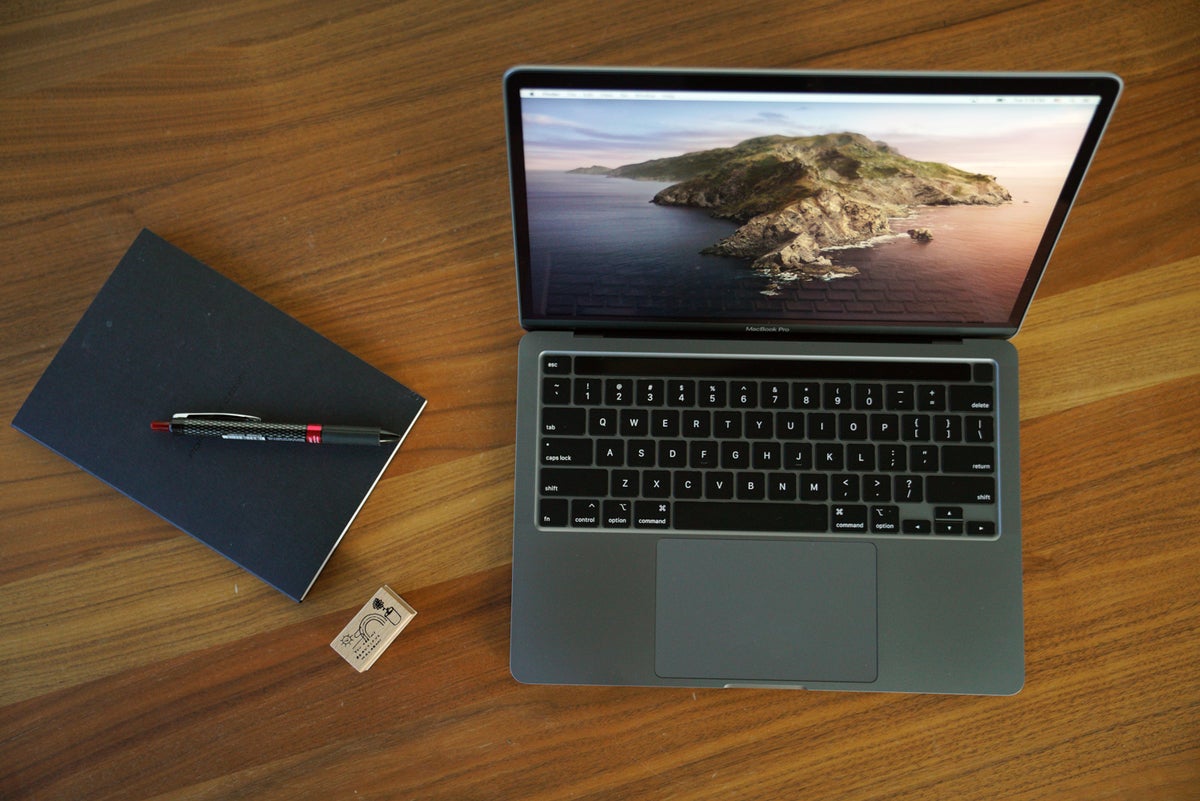 Willis Lai/IDG
Willis Lai/IDG
Goodbye, butterfly keyboard. Hello, Magic Keyboard, as well as dedicated ESC and Touch ID keys along the sides of the Touch Bar, and half-height arrow keys.
Apple’s Touch Bar is alive and well on the 13-inch MacBook Pro. For the unfamiliar, the Touch Bar is a touchscreen strip at the top of the keyboard, replacing the Function keys you might be used to seeing. The keys that appear on the Touch Bar depend on the app you’re using. For example, if you are in Maps, buttons can appear for getting directions, searching for a location, marking a location as a favorite, and more.
The Touch Bar can be a useful way to use your Mac, but after years of using Touch Bar-equipped laptops (Touch Bar was introduced in 2016), I still can’t get myself to use it on a regular basis. The Touch Bar can be customized for your use, so it doesn’t always have to display app-based options, but even with that I can’t develop a habit of using it. I hesitate to say it’s unnecessary, because I don’t think it’s poorly implemented. I just can’t get myself to remember that it’s there to use for more than just F-key functions.
Faster CPU and memory, boosted graphics
The new $1,799 and $1,999 13-inch MacBook Pros feature 10th-generation Intel Core processors, and they replace eight-generation processors in their predecessors. The $1,799 and $1,999 laptops both have a 2.0GHz quad-core Core i5 CPU with Turbo Boost up to 3.8GHz and 6MB L3 cache. The previous processor was a 2.4GHz quad-core Core i5, but the new processor is based on Intel’s Ice Lake microarchitecture that provides better performance, so the older CPU’s higher clock speed doesn’t mean much. For an additional $200, you can upgrade to a 2.3GHz quad-core Core i7 processor, which has Turbo Boost up to 4.1GHz.
Apple also provides faster memory in the new 13-inch MacBook Pro. The 2133MHz LPDDR3 RAM in the previous laptop has been upgraded to 3733MHz LPDDR4X, which should help boost performance. Standard configurations now start at 16GB of memory; it used to be 8GB. And Apple now offers a 32GB upgrade, which is an additional $400.
Pro users should especially take note of the Intel Iris Plus Graphics in the new laptop. You can now connect one 6K display (which you couldn’t do before), such as Apple’s Pro Display XDR, or one 5K display. Or you can connect up to two 4K displays. It’s still an integrated GPU, and it shares its graphics memory with the Mac’s main memory. According to Apple, the Iris Plus has 33 percent more execution units than its predecessor (64 instead of 48), so you should see a noticeable graphics performance improvement.
Performance
A few days ago we posted our Geekbench 5 results and found a 24 percent increase in single-core performance over the previous $1,799 2.4GHz quad-core Core i5 MacBook Pro and the $1,299 1.4GHz quad-core Core i5 model. In multi-core testing, the boost was 14 percent. The new MacBook Pro’s results in the Metal graphics test were the most impressive, with a 30 percent increase by the Iris Plus over the Iris Plus Graphics 645, and more than double the performance of the Intel UHD 630, which can be found in Apple’s 16-inch MacBook Pro. Check out our article to get more details on those results.
Geekbench 5 multi-core results
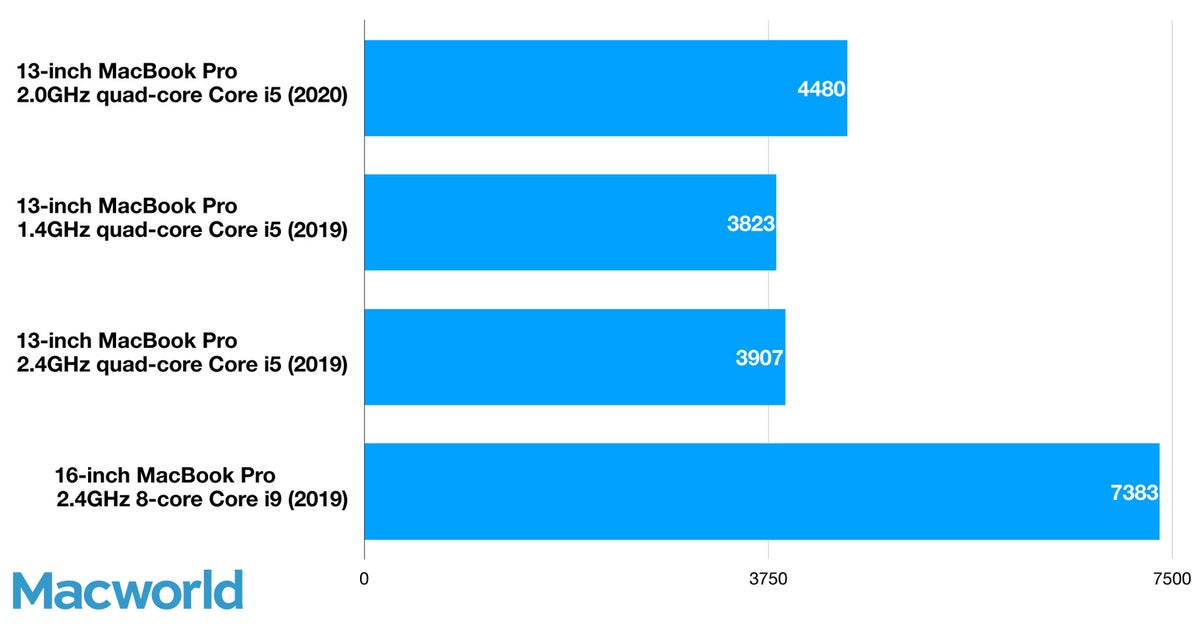 IDG
IDG
Results are scores. Longer bars/higher scores are better. Click to enlarge.
We ran a few other benchmarks to gauge the new laptop’s performance. In this section of testing, we looked at the new $1,799 MacBook Pro and the most affordable 13-inch MacBook Pro priced at $1,299 with a 1.4GHz quad-core eighth-generation Core i5. In addition to two more Thunderbolt 3/USB-C ports, the extra $500 you’d spend gets you an up-to-date processor, more and faster RAM, double the SSD storage, and more robust graphics. That should add up to better performance. We wanted a sense of how much more performance you can get.
Cinebench R20 CPU
 IDG
IDG
Results are scores. Higher results/longer bars are better. Click to enlarge.
The Cinebench R20 benchmark is a CPU multi-thread benchmark that is more intensive than Geekbench 5’s Multi-Core CPU test. The 2.0GHz quad-core Core i5 is a bit over 16 percent faster than the 1.4GHz quad-core Core i5. Cinebench is a rendering test, so this result is of particular interest for graphics professionals.
Blender BMW
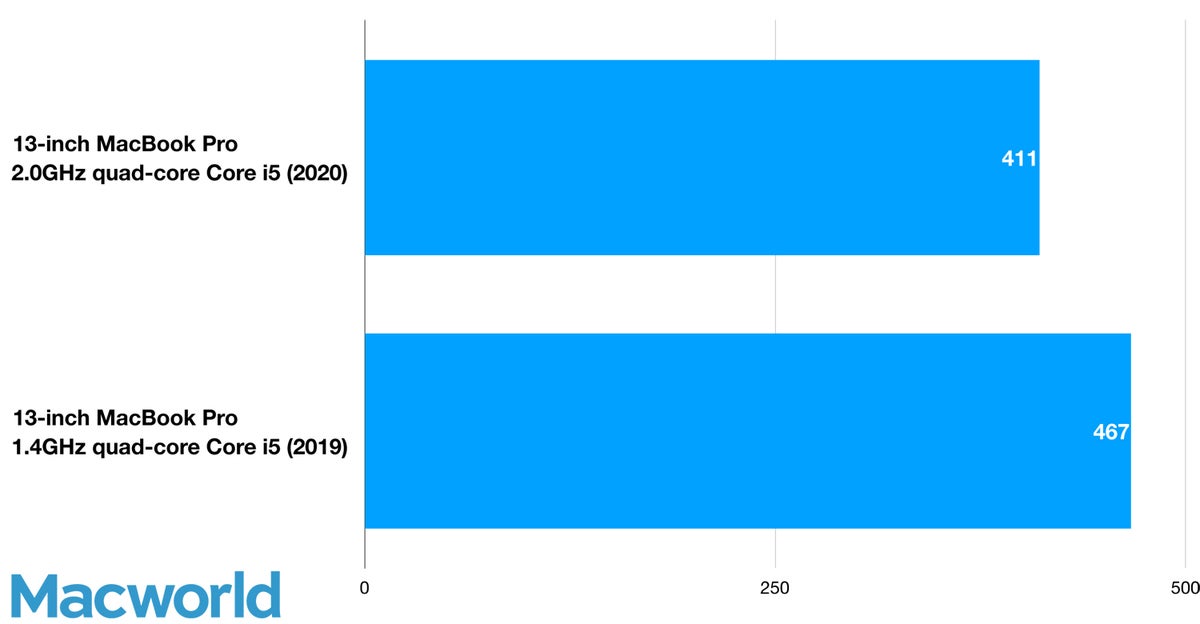 IDG
IDG
Results are times in seconds. Shorter bars/lower results are better. Click to enlarge.
This is another rendering test. Here we see a 12 percent improvement by the 2.0GHz quad-core Core i5.
Unigine Heaven
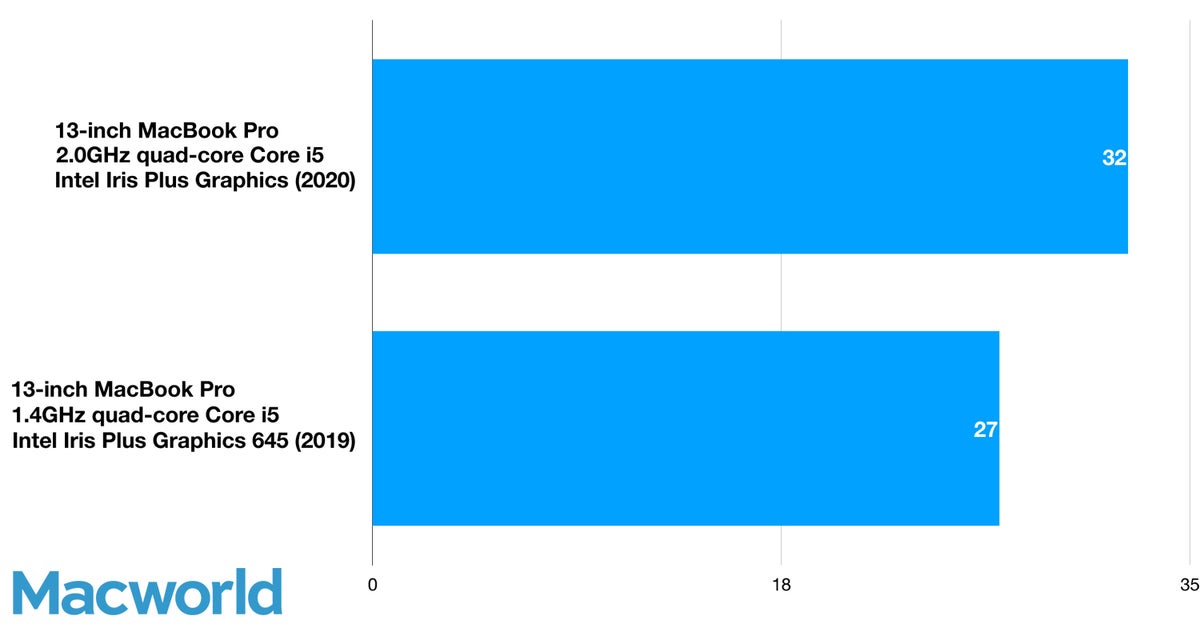 IDG
IDG
Results are frames per second. Higher results/longer bars are better. Click to enlarge.
Unigine Valley
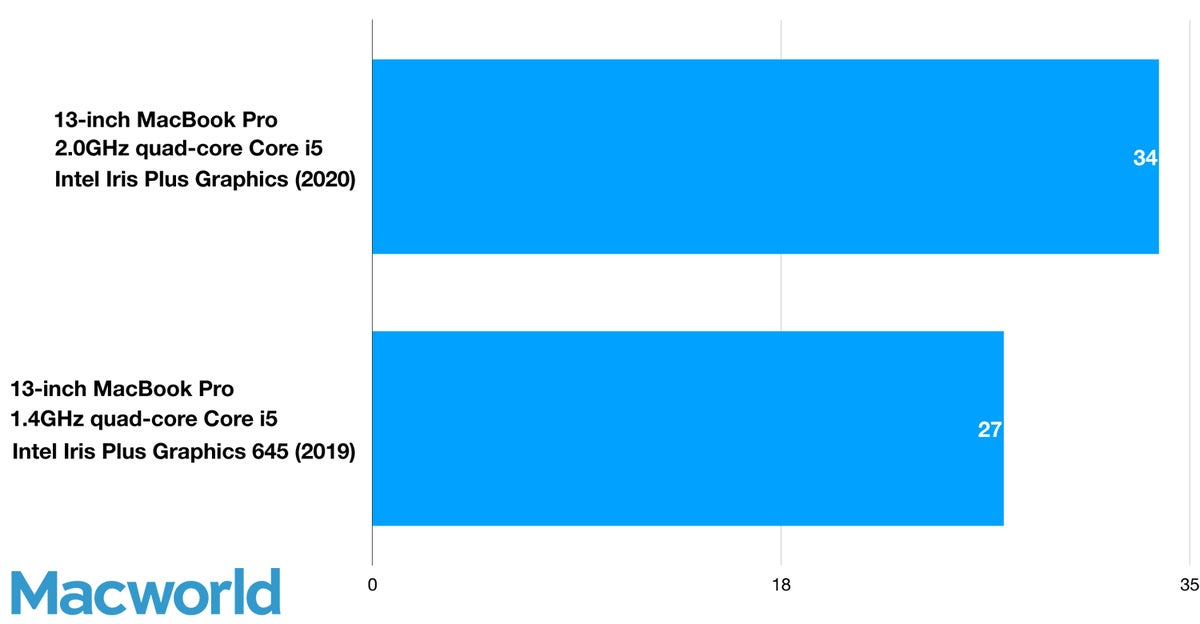 IDG
IDG
Results are frames per second. Higher results/longer bars are better. Click to enlarge.
The Unigine Heaven and Valley benchmarks are real-time graphics tests that focus on GPU performance. The newer MacBook Pro was 16 percent faster in Heaven, and 20 percent faster in Valley.
Handbrake 4K to 1080p video encode
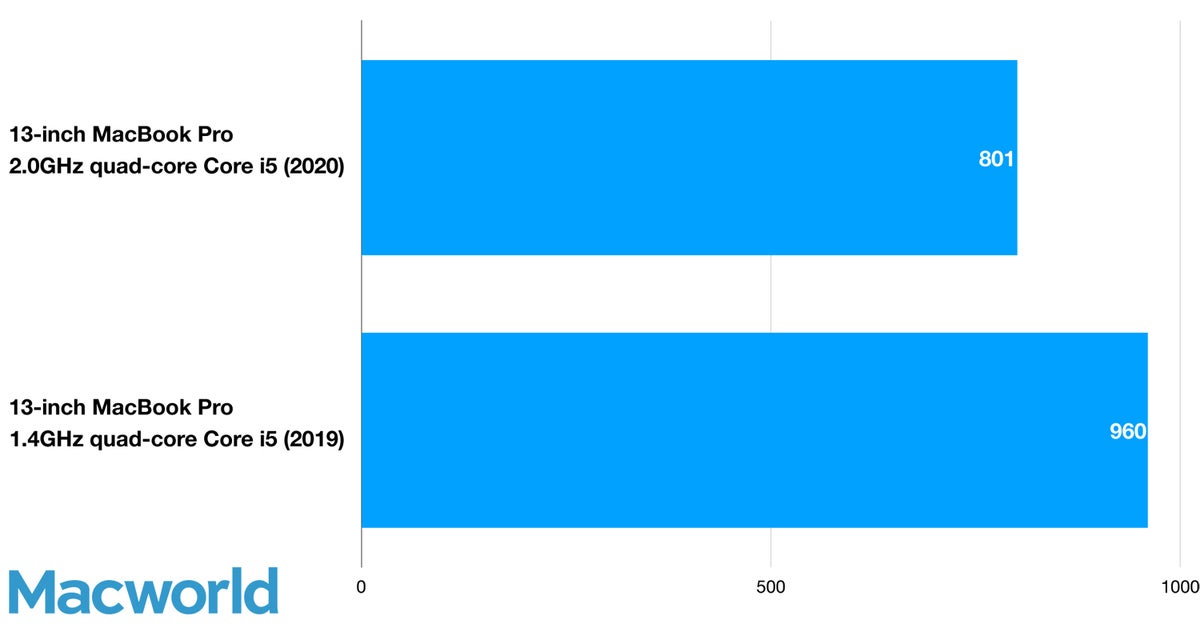 IDG
IDG
Results are times in seconds. Shorter bars/lower results are better. Click to enlarge.
We took the 4K video Tears of Steel and converted it using the Fast 1080p30 preset in Handbrake. The 2.0GHz quad-core Core i5 is about 17 percent faster than the 1.4GHz quad-core Core i5.
We ran several other benchmarks tests. You can take at the results on the results page.
Battery life
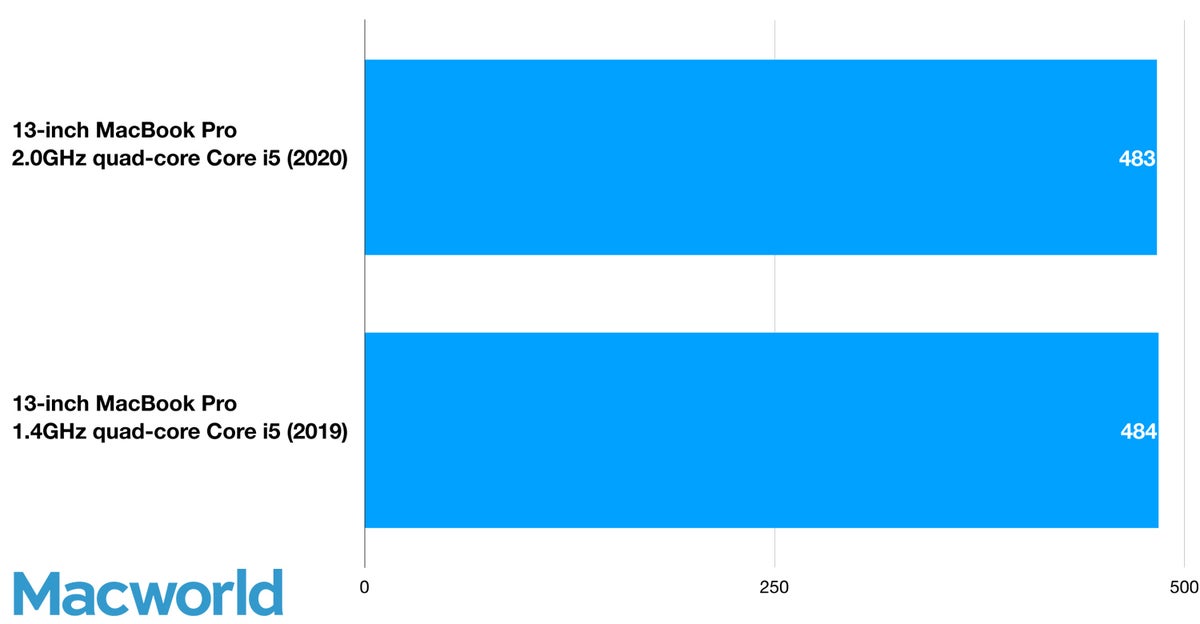 IDG
IDG
Results are times in minutes. Longer bars/higher times are better. Click to enlarge.
Rated at 58-watt hours, the battery in the $1,799 and $1,999 MacBook Pros are a little bit smaller than the one in the lower-cost models, which are rated at 58.2-watt hours. Apple’s says the battery will last for “up to 10 hours wireless web, up to 10 hours Apple TV app movie playback.”
To test the battery life, we looped a video until the battery ran out. (We should note that in this situation, instead of setting the display brightness at 150 nits as we usually do, we set the brightness slider in system preferences to about 90 percent.) We tested both the new laptop and the $1,299 model, and both laptops lasted just over 8 hours. The new laptop had no problem making through a regular workday, which involved using different business apps, internet access, and the occasional viewing of an internet video.
13.3-inch display, not 14 inches
Apple’s MacBook Pro lineup saw a significant shift when the company released the 16-inch MacBook Pro, whose predecessor was a 15-inch model. The bigger display was accomplished mostly by reducing the black bezel surrounding it. So naturally, when rumors about the successor to the 2019 13-inch MacBook Pro started to appear, it included speculation that the same bezel treatment would be used, creating a new 14-inch MacBook Pro.
That didn’t happen. The display is the same as before, with the same thick black bezels. It’s still a 500-nit Retina display, with a 2560x1600 resolution and support for the P3 wide color gamut and True Tone. And it still looks excellent, with even backlighting, sharp text, and nice color.
But it’s disappointing that the 14-inch display didn’t happen. My personal preference is for larger screens, but besides that, there’s an aesthetic with the bezel that didn’t really catch my eye until the 16-inch MacBook Pro was released, and it’s emphasized even more if you also use an iPhone that doesn’t have a Home button. The bigger bezel looks dated, on the brink of looking old, even. The design of the MacBook Pro lineup has been in place for years, so looking dated is an eventuality, but the reduced bezel on the 16-inch model was enough to give the design a bit of a refreshed, modern look.
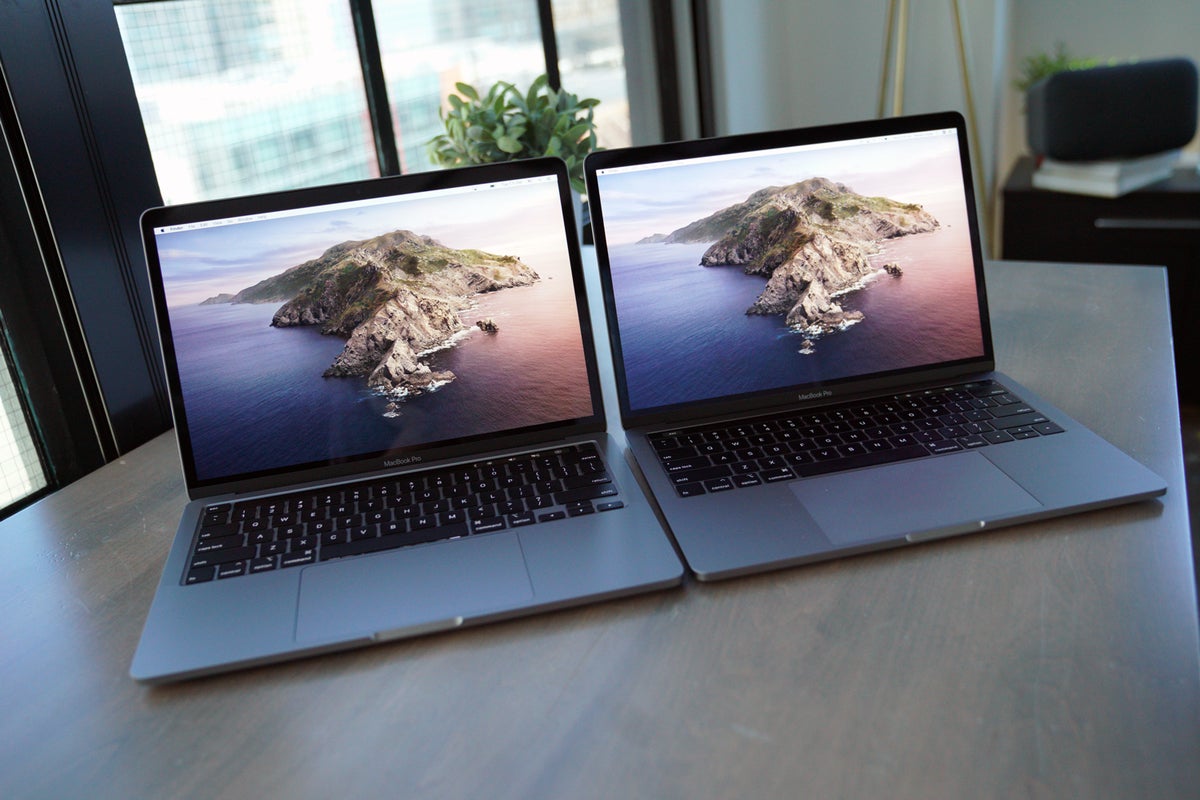 Willia Lai/IDG
Willia Lai/IDG
The new MacBook Pro (left) has the same 500-nit, 2560-by-1600 backlit Retina display as its predecessor (right). Including the big bezel.
Obviously, Apple made a design decision to not change the bezel. We can only speculate as to why. There have been rumors that Apple will be releasing a ARM-based Mac laptop, maybe even as soon as 2021, and perhaps there’s some line of thinking that ties significant design changes to that. Or maybe there’s a more practical reason: maybe there are performance and heat issues with using a larger display in this small of a form factor. At this point, it’s all purely conjecture.
Storage and other features
Apple also took this opportunity to adjust the standard SSD configurations of the 13-inch MacBook Pro. Gone is the 128GB SSD configuration—thank goodness. Apple’s lineup now starts at 256GB and tops off at 1TB, with two 512GB models in-between. You can adjust the amount of storage, all the way up to 2TB, if you want to pay more.
The $1,299 and $1,499 models each have two Thunderbolt 3/USB-3 ports, while the $1,799 and $1,999 models have four. If you haven’t already, you might want to consider buying a USB-C hub, especially if you have external devices that use a USB-A connector. You can check our guide to see what adapters you might need.
Apple introduced a new 6-speaker system in the 16-inch MacBook Pro that sounds pretty powerful. The new 13-inch MacBook Pro didn’t get the same treatment, however. It still has the same wide stereo speaker system as before. And it sounds fine, but it’s clearly not in the same league as the 16-inch model.
In this time of sheltering in place and working remotely, new attention has been brought upon the FaceTime camera in Apple’s laptops. It’s still a 720p camera, and its image quality is very disappointing, especially when you compare it to the front-facing cameras on modern iPhones. It’s gone too long without being upgraded.
Bottom line
Apple users have been waiting for an upgrade to the 13-inch MacBook Pro. The question here is, is there enough in the new laptop to be worth the investment? There’s certainly enough here for professionals to consider, especially if the MacBook Pro you’re using is more than two years old. While the CPU boost is noticeable, you’ll especially like the increase in graphics performance.
For the general consumer, if you aren’t spending most of your time in pro apps that can take advantage of the faster graphics, and you have a 13-inch MacBook Pro that was bought within the past four years, you’re probably fine for now. However, there is that new Magic Keyboard, and if you’re absolutely tired of the butterfly keyboard, make the switch. Your hands will thank you.
After testing the 16-inch MacBook Pro last November and now this model, one thing is clear to me: I’m ready for some drastic changes to the MacBook lineup. The rumors of Apple making an ARM-based laptop persist, and it could happen next year, starting with a consumer-level machine. That would mean the MacBook Pro would remain unchanged (at that moment), but a new ARM-based laptop would show where Apple is headed with the technology and design. It could bring back some much-needed excitement to Apple’s laptop lineup.

















